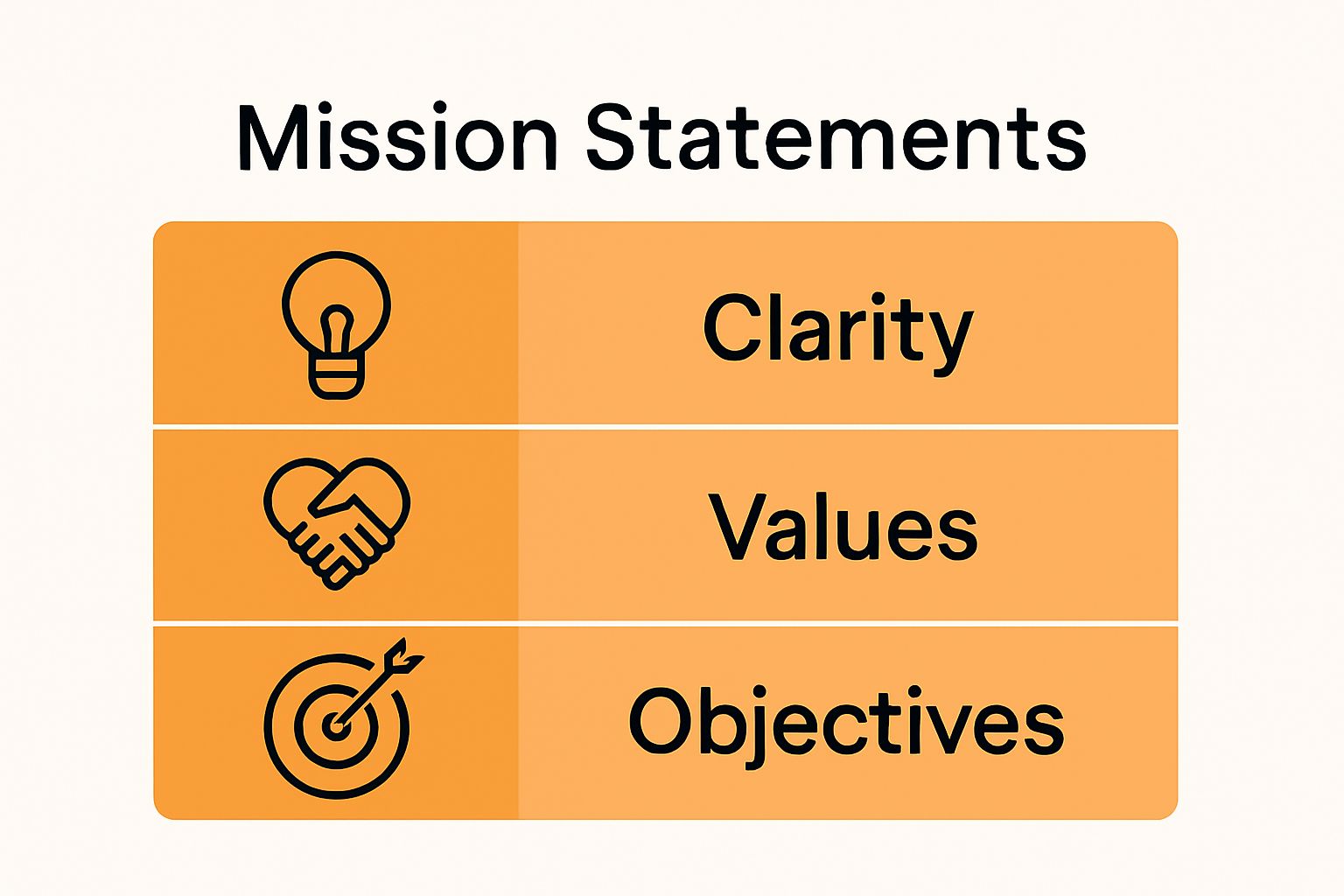
Understanding Agency Mission Statements for Success
Agency mission statements do a lot more than sit unnoticed on a company wall. Some research shows that organizations with compelling mission statements see far higher employee commitment and better performance. Most people expect these to be just words. The real surprise is how these statements actually transform culture and drive real results inside thriving companies.
Table of Contents
- What Are Agency Mission Statements?
- The Importance Of Agency Mission Statements
- Key Components Of Effective Agency Mission Statements
- How Agency Mission Statements Influence Organizational Culture
- Real-World Examples Of Successful Agency Mission Statements
Quick Summary
| Takeaway | Explanation |
|---|---|
| Craft a clear mission statement | A concise mission statement defines your agency’s core purpose and values. |
| Align mission with strategy | Ensure the mission statement guides decision-making and resource allocation within the organization. |
| Use mission for employee engagement | A compelling mission can motivate employees by creating a sense of purpose and unity. |
| Differentiate your agency externally | A strong mission statement helps attract clients and talent by communicating unique value propositions. |
| Revise mission as needed | Regularly update the mission statement to reflect the agency’s evolving identity and objectives. |
What are Agency Mission Statements?
An agency mission statement represents a concise, strategic declaration that articulates an organization’s fundamental purpose, core values, and primary objectives. These statements serve as powerful communication tools that define an agency’s unique identity, guiding principles, and ultimate organizational goals.
Defining the Core Purpose
Agency mission statements go beyond mere corporate rhetoric. They capture the essence of why an organization exists and what meaningful impact it seeks to create in its chosen industry or market. Understanding agency value propositions helps agencies develop more precise and compelling mission statements that resonate with their target audience.
Key characteristics of effective agency mission statements include:
- Clarity about the organization’s fundamental purpose
- Reflection of the agency’s unique value and approach
- Inspiration for internal teams and stakeholders
- Alignment with long-term strategic objectives
Strategic Significance
Mission statements play a critical role in organizational strategy by providing a north star for decision making, resource allocation, and team motivation. According to Harvard Business Review, well-crafted mission statements can significantly influence an organization’s culture, performance, and strategic direction.
These statements are not static documents but dynamic representations of an agency’s evolving identity. They communicate not just what an agency does, but why it does it, creating a narrative that connects the organization’s work to broader societal or industry objectives. By articulating a clear and compelling mission, agencies can differentiate themselves, attract top talent, and build stronger connections with clients who share similar values and aspirations.
The Importance of Agency Mission Statements
Agency mission statements are far more than decorative documents hanging on office walls. They represent critical strategic tools that shape organizational culture, drive performance, and communicate an agency’s fundamental value proposition to both internal and external stakeholders.
Strategic Alignment and Focus
Mission statements function as powerful navigational compasses for agencies, providing clear direction and strategic alignment across all organizational levels. Developing core values becomes significantly more effective when anchored to a well-articulated mission statement that reflects the agency’s deeper purpose.
Key strategic benefits include:
- Establishing a unified organizational vision
- Creating consistent decision making frameworks
- Guiding resource allocation and strategic priorities
- Generating collective motivation among team members
External Perception and Branding
Beyond internal dynamics, mission statements play a crucial role in shaping external perceptions. According to McKinsey & Company, organizations with clear, compelling mission statements are more likely to attract top talent, build stronger client relationships, and differentiate themselves in competitive markets.
A well-crafted mission statement communicates an agency’s unique value proposition, highlighting not just what services are offered, but the underlying philosophy and commitment that distinguishes the organization. It transforms a simple business description into a narrative that resonates emotionally with clients, employees, and potential partners, creating deeper connections beyond transactional interactions.
Key Components of Effective Agency Mission Statements
Crafting a powerful agency mission statement requires careful consideration of multiple strategic elements that transform a generic declaration into a compelling organizational blueprint. The most impactful mission statements are not merely words on paper but dynamic representations of an agency’s core identity and aspirational trajectory.
Essential Structural Elements
Effective mission statements share critical structural characteristics that ensure clarity, resonance, and strategic utility. Understanding agency financial management reinforces the importance of strategic alignment in mission statement development, ensuring that organizational goals translate into tangible operational outcomes.
Critical structural components include:

- Concise and clear language
- Authentic representation of organizational values
- Forward looking perspective
- Specific yet adaptable framework
Qualitative Dimensions
Beyond structural considerations, mission statements must capture deeper qualitative dimensions that communicate an agency’s unique value proposition. According to Stanford Social Innovation Review, the most compelling mission statements transcend mere functional descriptions, instead creating emotional connections that inspire stakeholders.
A truly effective mission statement communicates three fundamental elements: the organization’s core purpose, its distinctive approach, and the broader impact it seeks to create. This multidimensional approach transforms a mission statement from a static document into a dynamic strategic tool that guides decision making, attracts talent, and builds organizational cohesion.
Below is a table summarizing the essential structural and qualitative components that make agency mission statements effective, as described in the article.
| Component Type | Description |
|---|---|
| Concise Language | Clear, brief wording that communicates the agency’s message |
| Authentic Values | Genuine representation of organizational beliefs and principles |
| Forward Perspective | Vision that looks to the future and sets aspirational direction |
| Specific yet Flexible | Allows adaptability while maintaining organizational focus |
| Core Purpose | The fundamental reason for the agency’s existence |
| Distinctive Approach | Unique method or philosophy distinguishing the agency |
| Broader Impact | The effect the agency aims to have on its industry or society |
How Agency Mission Statements Influence Organizational Culture
Agency mission statements are powerful cultural architects that shape an organization’s internal dynamics, employee behavior, and collective identity. Far from being mere rhetorical statements, they serve as fundamental frameworks that guide decision making, inspire team performance, and create a shared sense of purpose.
Cultural Alignment and Employee Engagement
Mission statements act as critical mechanisms for cultural integration, transforming abstract organizational goals into tangible behavioral expectations. Understanding the agency business model demonstrates how mission statements provide a foundational blueprint for aligning individual employee actions with broader organizational objectives.
Key cultural influence mechanisms include:
- Creating a unified organizational narrative
- Establishing shared values and behavioral expectations
- Providing psychological motivation beyond financial compensation
- Generating a sense of collective identity and purpose
Psychological and Performance Dynamics
The psychological impact of a compelling mission statement cannot be overstated. According to Harvard Business Review, organizations with strong, well-communicated mission statements experience significantly higher levels of employee commitment, discretionary effort, and overall organizational resilience.
A strategically crafted mission statement transcends traditional communication, functioning as an emotional and intellectual anchor that connects individual team members to something larger than their immediate job responsibilities. By articulating a meaningful purpose, agencies can transform workplace dynamics from transactional interactions to purposeful collaborations that inspire innovation, mutual accountability, and sustained organizational growth.
This table organizes the main ways agency mission statements influence organizational culture and employee engagement, highlighting their cultural and psychological impacts.
| Influence Mechanism | How It Benefits the Organization |
|---|---|
| Unified Organizational Narrative | Aligns everyone with a common story and sense of direction |
| Shared Values | Establishes expected behaviors and ethical standards |
| Psychological Motivation | Inspires effort, loyalty, and resilience beyond financial incentives |
| Collective Identity | Fosters belonging and pride within the agency |
| Discretionary Effort | Encourages employees to go above and beyond their basic responsibilities |
| Purposeful Collaboration | Promotes teamwork and innovation across the organization |
| Sustained Organizational Growth | Strengthens long-term performance and adaptability |

Real-World Examples of Successful Agency Mission Statements
Examining successful mission statements provides invaluable insights into how organizations articulate their fundamental purpose, values, and strategic objectives. These real-world examples demonstrate the power of concise, compelling organizational narratives that transcend mere corporate communication.
Technology and Innovation Sector
Leading technology companies offer exceptional illustrations of mission statements that capture both aspirational vision and practical commitment. What is operational excellence becomes particularly evident when examining how mission statements translate into organizational strategy.
Compelling mission statement examples include:
- Google: “To organize the world’s information and make it universally accessible and useful”
- Tesla: “To accelerate the world’s transition to sustainable energy”
- Airbnb: “Belong anywhere”
Social Impact and Service Organizations
Non technological agencies demonstrate equally powerful mission statements that communicate deeper societal purposes. According to Federal Bureau of Investigation, an exemplary mission statement can powerfully articulate an organization’s core commitment. The FBI’s mission “To protect the American people and uphold the Constitution of the United States” perfectly illustrates how a mission statement can simultaneously define operational scope and fundamental ethical principles.
A truly remarkable mission statement transforms from a simple declaration into a strategic compass that guides organizational behavior, inspires stakeholders, and creates a clear sense of purpose. These examples reveal that the most effective mission statements are not just about what an organization does, but about the meaningful impact it seeks to create in the world.
Turn Your Mission Statement Into Real Agency Growth
Is your agency mission statement inspiring enough to drive team action or just words on the wall? Many agency leaders struggle to translate their mission into day-to-day decisions, clear organizational culture, and steady business growth. As highlighted in the article, effective mission statements are dynamic tools for strategic alignment and building a unified agency vision. But making this leap alone can be difficult. The pressure to stand out in the digital marketing and consulting world makes it even more urgent to connect your stated purpose with measurable results that resonate inside and outside your business.

Ready to move your agency from talk to tangible transformation? With expert business growth coaching at Agency Firestarter, you can bridge the gap between company values and clear successes. We coach agency owners to structure mission-driven teams, build leadership skills, and create a scalable path for growth. See how our tailored coaching and proven strategies can help you build a mission-powered agency. Start your transformation now at Agency Firestarter or explore leadership coaching solutions to unlock your team’s full potential.
Frequently Asked Questions
What is an agency mission statement?
An agency mission statement is a concise declaration that defines an organization’s core purpose, values, and objectives. To create one, start by identifying your agency’s unique identity and the meaningful impact you aim to make in your industry.
Why are agency mission statements important for success?
Agency mission statements are crucial as they provide a clear direction and strengthen organizational culture. To enhance your agency’s success, ensure that your mission statement resonates with your values and aligns with your long-term goals.
How do I create an effective agency mission statement?
To create an effective agency mission statement, use clear language that reflects your core purpose, unique value, and future aspirations. Begin by brainstorming essential elements that represent your agency’s identity and aim to draft a statement within 30 days.
What are the key components of a strong mission statement?
A strong mission statement should be concise, authentic, and future-oriented, capturing your organization’s core purpose and the impact you wish to achieve. Ensure your draft includes these components and solicit feedback from team members to refine it.
How can a mission statement influence employee engagement?
A well-crafted mission statement can boost employee engagement by providing a shared sense of purpose and aligning individual actions with organizational goals. Consider revising your current statement to highlight how it can motivate team members within the next few weeks.
How often should an agency review its mission statement?
An agency should review its mission statement regularly, ideally every one to two years, to ensure it remains relevant and reflective of the organization’s evolving identity. Schedule a review process to assess and update your mission statement if needed.
Recommended
- Understanding Agency Value Proposition for Growth – Business Coach For Digital Marketing Companies, SEO, Social Media Agencies
- Understanding the Agency Business Model: Key Insights – Business Coach For Digital Marketing Companies, SEO, Social Media Agencies
- Understanding Agency Financial Management: Key Concepts Explained – Business Coach For Digital Marketing Companies, SEO, Social Media Agencies
- 7 Team Motivation Techniques to Boost Your Agency’s Performance – Business Coach For Digital Marketing Companies, SEO, Social Media Agencies
